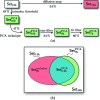Single-particle imaging without symmetry constraints at an X-ray free-electron laser
- PMID: 30443357
- PMCID: PMC6211532
- DOI: 10.1107/S205225251801120X
Single-particle imaging without symmetry constraints at an X-ray free-electron laser
Abstract
The analysis of a single-particle imaging (SPI) experiment performed at the AMO beamline at LCLS as part of the SPI initiative is presented here. A workflow for the three-dimensional virus reconstruction of the PR772 bacteriophage from measured single-particle data is developed. It consists of several well defined steps including single-hit diffraction data classification, refined filtering of the classified data, reconstruction of three-dimensional scattered intensity from the experimental diffraction patterns by orientation determination and a final three-dimensional reconstruction of the virus electron density without symmetry constraints. The analysis developed here revealed and quantified nanoscale features of the PR772 virus measured in this experiment, with the obtained resolution better than 10 nm, with a clear indication that the structure was compressed in one direction and, as such, deviates from ideal icosahedral symmetry.
Keywords: XFELs; single-particle imaging; three-dimensional virus reconstructions.
Figures





 r.m.s. around the mean value) were selected for further analysis.
r.m.s. around the mean value) were selected for further analysis.

 for even order difference spectra Fourier components. (a) Set14k and (b) Set8k
excluded have very similar features which suggests that Set8k
excluded with presumably non-single hits dominates the properties of Set14k. (c) Set7k
PCA consists of the PCA single-hit selection and shows more pronounced features.
for even order difference spectra Fourier components. (a) Set14k and (b) Set8k
excluded have very similar features which suggests that Set8k
excluded with presumably non-single hits dominates the properties of Set14k. (c) Set7k
PCA consists of the PCA single-hit selection and shows more pronounced features.




Similar articles
-
An advanced workflow for single-particle imaging with the limited data at an X-ray free-electron laser.IUCrJ. 2020 Oct 15;7(Pt 6):1102-1113. doi: 10.1107/S2052252520012798. eCollection 2020 Nov 1. IUCrJ. 2020. PMID: 33209321 Free PMC article.
-
Diffraction data from aerosolized Coliphage PR772 virus particles imaged with the Linac Coherent Light Source.Sci Data. 2020 Nov 19;7(1):404. doi: 10.1038/s41597-020-00745-2. Sci Data. 2020. PMID: 33214568 Free PMC article.
-
Flash X-ray diffraction imaging in 3D: a proposed analysis pipeline.J Opt Soc Am A Opt Image Sci Vis. 2020 Oct 1;37(10):1673-1686. doi: 10.1364/JOSAA.390384. J Opt Soc Am A Opt Image Sci Vis. 2020. PMID: 33104615
-
Virus Structures by X-Ray Free-Electron Lasers.Annu Rev Virol. 2019 Sep 29;6(1):161-176. doi: 10.1146/annurev-virology-092818-015724. Annu Rev Virol. 2019. PMID: 31567066 Review.
-
Methods and application of coherent X-ray diffraction imaging of noncrystalline particles.Biophys Rev. 2020 Apr;12(2):541-567. doi: 10.1007/s12551-020-00690-9. Epub 2020 Mar 16. Biophys Rev. 2020. PMID: 32180121 Free PMC article. Review.
Cited by
-
Finding the semantic similarity in single-particle diffraction images using self-supervised contrastive projection learning.NPJ Comput Mater. 2023;9(1):24. doi: 10.1038/s41524-023-00966-0. Epub 2023 Feb 16. NPJ Comput Mater. 2023. PMID: 38666059 Free PMC article.
-
Prospects for coherent X-ray diffraction imaging at fourth-generation synchrotron sources.IUCrJ. 2025 May 1;12(Pt 3):280-287. doi: 10.1107/S2052252525001526. IUCrJ. 2025. PMID: 40080160 Free PMC article.
-
Skopi: a simulation package for diffractive imaging of noncrystalline biomolecules.J Appl Crystallogr. 2022 Jul 15;55(Pt 4):1002-1010. doi: 10.1107/S1600576722005994. eCollection 2022 Aug 1. J Appl Crystallogr. 2022. PMID: 35974743 Free PMC article.
-
Experimental 3D coherent diffractive imaging from photon-sparse random projections.IUCrJ. 2019 Mar 20;6(Pt 3):357-365. doi: 10.1107/S2052252519002781. eCollection 2019 May 1. IUCrJ. 2019. PMID: 31098017 Free PMC article.
-
High spatial coherence and short pulse duration revealed by the Hanbury Brown and Twiss interferometry at the European XFEL.Struct Dyn. 2021 Aug 23;8(4):044305. doi: 10.1063/4.0000127. eCollection 2021 Jul. Struct Dyn. 2021. PMID: 34476285 Free PMC article.
References
-
- Als-Nielsen, J. & McMorrow, D. (2011). Elements of Modern X-ray Physics, 2nd ed. Chichester: Wiley.
-
- Altarelli, M., Brinkmann, R., Chergui, M., Decking, W., Dobson, B., Düsterer, S., Grübel, G., Graeff, W., Graafsma, H., Hajdu, J., Marangos, J., Pflüger, J., Redlin, H., Riley, D., Robinson, I., Rossbach, J., Schwarz, A., Tiedtke, K., Tschentscher, T., Vartaniants, I., Wabnitz, H., Weise, H., Wichmann, R., Witte, K., Wolf, A., Wulff, M. & Yurkov, M. (2006). Editors. XFEL: The European X-ray Free-Electron Laser. Technical Design Report 2006–097. Hamburg: DESY.
-
- Altarelli, M., Kurta, R. P. & Vartanyants, I. A. (2010). Phys. Rev. B, 82, 104207.
-
- Aquila, A., Barty, A., Bostedt, C., Boutet, S., Carini, G., dePonte, D., Drell, P., Doniach, S., Downing, K. H., Earnest, T., Elmlund, H., Elser, V., Gühr, M., Hajdu, J., Hastings, J., Hau-Riege, S. P., Huang, Z., Lattman, E. E., Maia, F. R. N. C., Marchesini, S., Ourmazd, A., Pellegrini, C., Santra, R., Schlichting, I., Schroer, C., Spence, J. C. H., Vartanyants, I. A., Wakatsuki, S., Weis, W. I. & Williams, G. J. (2015). Struct. Dyn. 2, 041701. - PMC - PubMed

